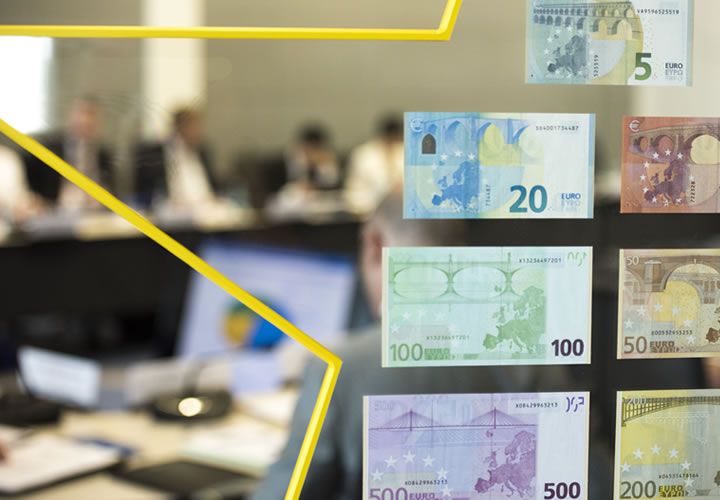EUR/USD Rate Extends post-FOMC Rally, "Key Reversal" Advocates for Further Advances to 1.1165
Following the release of the US Federal Reserve's July policy decision the EUR/USD has traded with a positive tone and analysts look for further advances near-term.
- EUR/USD rate at 1.1096 today
- Year-ahead forecasts from BMO Capital show 1.10 likely, but fall to 1.07 in 3-6 months possible
The Euro to Dollar exchange rate is moving higher into the final session of the week, and month.
The move higher was sparked by a bout of widespread USD weakness owed to the US Federal Reserve Open Markets Committee (FOMC) statement which implied markets should not expect an interest rate rise until we are closer to the end of 2016.
This deflated the Dollar bulls who were seen bidding the currency higher in anticipation of an imminent move.
"EUR/USD has seen a strong rebound from the 1.0941 4 month support line. The price action on Wednesday was a key day reversal and there is scope for a retest of the recent highs at 1.1165/87 –
these maintain our negative bias short term," says Karen Jones, a technical analyst with Commerzbank.
Only once a break below 1.0941 occurs does Jones believe the rate will target 1.0821, the March low, and then the 31 year support line at 1.0642.
Note the 1.0457 March 2015 low is also found in this vicinity together with the 1.0574 channel.
"Initial resistance are the recent highs at 1.1165/87 and we look for the market to fail here. Above here lies 1.1264 the 50% retracement of the move down from May," says Jones.
A Docile Fed Does Not Justify a Weaker EUR/USD
For foreign currencies the timing of US Fed interest rate rises are critical as higher US interest rates will likely shift global capital flows back towards the US. This should boost the currency against its competitors and, for example, is one reason why some are arguing for the GBP/USD rate to fall to 1.20.
The July statement from the Fed showed policy-setters continue to closely monitor global and financial developments, as was the case in June.
The Fed did however upgrade its assessments of the economy and the labour market.
It now suggests that risks have diminished which is a new and significant addition.
"The takeaway is that the Fed is clearly eying higher rates this year. The dollar reacted positively initially, but the move was quickly corrected and the dollar weakened as the FOMC refrained from sending any clear signals of a September hike," says Erica Blomgren at SEB.
Ralf Umlauf at Helaba Research in Frankfurt says the 'docile' Fed does not justify any extended weakness in EUR/USD and he expects, "the post-referendum range to continue for the time being, at 1.0910 to the downside and 1.1186 to the upside.”
Umlauf believes the region around the 200-day moving average (1.1076) will continue forming a centre of gravity for the pair with a trading range existing between 1.0910 and 1.1050.
Looking further ahead, strategists at Societe Generale reckon any short-term gains will ultimately give way to a continued grind lower.
Soc Gen studies note that while EUR/USD temporarily pierced graphical levels of 1.1460 it continues to undergo a retracement:
“It has breached below an ascending channel and has hit an intermittent target at 1.09, a projection for the down move,” says Soc Gen’s Head of Technical Analysis, Stéphanie Aymes.
With monthly indicators near resistance, Aymes says a move towards February lows of 1.08 looks likely.
BMO Capital Forecast 1.07, Before Return to a Familiar 1.10
Quarterly forecasts, just released by BMO Capital Markets, show that the present period of decline are likely to see 1.07 tested over a 3-6 month timeframe.
Writing to clients form London, BMO Capital's Stephen Gallo says asset scarcity will persistently cap yields which should in turn ensure any strength in the shared currency remains limited.
Furthermore, weak investment spending is expected to weigh on corporate issuance and limited fiscal stimulus weighs on government issuance.
Furthermore, there are political considerations that will provide a great deal of confidence-sapping uncertainty.
Italy faces a big dilemma: "With a state-backed bank bailout, PM Renzi undermines Brussels and the EU’s
legitimacy. Without one, a private creditor bail-in strengthens Italy’s anti-establishment parties. A middle-of-theroad compromise or a fudge won’t halt Italy’s growth recession or financial sector malaise," says Gallo.
Gallo also believes that the required big reforms which strengthen the single market in services, improve EU growth and raise its survivability odds are unlikely.
The Netherlands, France and Germany all head to the polls in 2017. However, we expect the UK & EU to
formulate arrangements over the next 12M to preserve free trade in goods for the UK (and possibly services).
"We expect EURUSD to trade at 1.07 in 3M and 1.10 in 12M. Post-Brexit uncertainties and additional ECB easing will weigh on the EUR during risk-off, but the EUR’s funding currency status will also weigh during risk-on," says Gallo












